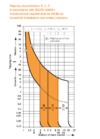You're merely indicating what BS7671 currently requires (although main bonding is not 'only' required to deal with the consequences of a lost PEN - apart from anything else, if that were the only reason for main bonding, it would only be required in TN-C-S installations!) - but that does not alter the electrical considerations that I described.There's no need for supplementary bonding now though on circuits with RCD protection, you only need to bond extraneous conductive parts to guard against loss of pen.
If there is a local L-CPC (or L-exposed-c-p) fault ('of negligible impedance') on a circuit wired with, say, 2.5mm² T+E, then the potential of exposed-c-ps related to that circuit will (until the fault is cleared) rise to roughly 62.5% of the supply voltage (i.e. about 144 V with a 230V supply) above MET potential. In the absence of SB in the location, the potential of exposed-c-ps associated with other circuits, or extraneous-c-ps, will remain at roughly MET potential - so, until the fault is cleared, there would be roughly a 144 V potential difference between some parts within the location - more than enough to kill someone who simultaneously touched 'the wrong two' parts.
That dangerous PD admittedly only persists "until the fault is cleared", and the hope is obviously that the fault would be cleared quickly enough to avoid any death. Although the same remains true in any room/location, BS7671 only addresses this issue in relation to bathrooms and, interesting in terms of the discussion we've been having, it only allows SB to be omitted if the circuits are RCD-protected (which it requires for any circuit supplying a bathroom, anyway!). In other words, it does not seem to regard the MCB/fuse alone as providing a degree of 'fault protection' adequate to justify the omission of SB.


